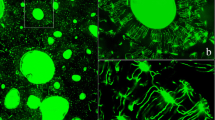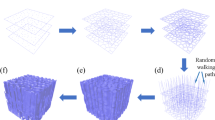Abstract
Purpose
To study the effects of dexamethasone sodium phosphate (Dex) on human trabecular meshwork (HTM) cells in vitro.
Methods
HTM cells were treated with Dex 2 mg/ml, 1 mg/ml, 0.5 mg/ml, 0.25 mg/ml, 0.1 mg/ml, or 0.05 mg/ml for 24 h. Cell viability was measured by a trypan blue exclusion test. Caspase-3/7, -8, -9 and -12 activities were measured by fluorochrome assays as mean signal intensity (msi) to assess apoptosis. Mitochondrial dehydrogenase activity was determined by a WST assay to quantify mitochondrial damage.
Results
Mean cell viabilities of HTM cells exposed to Dex at the higher doses of 2 mg/ml, 1 mg/ml, and 0.5 mg/ml were reduced: 11.9 % ± 3.5 (P < 0.001), 31.2 % ± 3.2 (P < 0.001), and 76.6 % ± 4.4 (P < 0.01). At the lower doses of 0.25 mg/ml, 0.1 mg/ml or 0.05 mg/ml, no significant cell viability reductions were seen: 96.3 % ± 0.7 (P > 0.05), 95.3 % ± 2.5 (P > 0.05) and 93.8 % ± 2.3 (P > 0.05), respectively compared to untreated HTM cells (97.0 % ± 1.9). Caspase-3/7 activity (msi) of HTM cells exposed to Dex 2, 1 or 0.5 mg/ml was 21068 ± 2498 (P < 0.001), 26994 ± 3104 (P < 0.001) and 20416 ± 1150 (P < 0.001) compared to untreated HTM cells 1148 ± 803. Caspase-9 activity (msi) of HTM cells after exposure to Dex 2, 1 or 0.5 mg/ml was 14188 ± 1203 (P < 0.001), 13256 ± 1564 (P < 0.001) and 15041 ± 1584 (P < 0.001) compared to untreated HTM cells 1748 ± 524. The lower doses of Dex did not significantly increase caspase-3/7 or -9 activities. There were no increases for caspase-8 or -12 activities at any of the tested Dex doses. The WST assay showed mitochondrial dehydrogenase activities of 14.3 ± 0.7 (P < 0.001), 9.6 ± 0.3 (P < 0.001) and 56.0 ± 7.6 (P < 0.001) at 2 mg/ml, 1 mg/ml and 0.5 mg/ml Dex compared to untreated HTM cells (186.1 ± 15.0).
Conclusions
Dex at 0.25, 0.1 and 0.05 mg/ml clinical dose did not cause significant reduction in cell viability, increased apoptosis, or mitochondrial dysfunction of HTM cells in vitro. At high doses (2, 1 or 0.5 mg/ml) Dex caused apoptosis via mitochondrial pathways.






Similar content being viewed by others
References
Kwak HW, D'Amico DJ (1992) Evaluation of the retinal toxicity and pharmacokinetics of dexamethasone after intravitreal injection. Arch Ophthalmol 110:259–266
Kuppermann BD, Blumenkranz MS, Haller JA, Williams GA, Weinberg DV, Chou C, Whitcup SM, Dexamethasone DDS Phase II Study Group (2007) Randomized controlled study of an intravitreous dexamethasone drug delivery system in patients with persistent macular edema. Arch Ophthalmol 125:309–317
Clark AF, Steely HT, Dickerson JE Jr, English-Wright S, Stropki K, McCartney MD, Jacobson N, Shepard AR, Clark JI, Matsushima H, Peskind ER, Leverenz JB, Wilkinson CW, Swiderski RE, Fingert JH, Sheffield VC, Stone EM (2001) Glucocorticoid induction of the glaucoma gene MYOC in human and monkey trabecular meshwork cells and tissues. Invest Ophthalmol Vis Sci 42:1769–1780
Beer PM, Bakri SJ, Singh RJ, Liu W, Peters GB 3rd, Miller M (2003) Intraocular concentration and pharmacokinetics of triamcinolone acetonide after a single intravitreal injection. Ophthalmology 110:681–686
Cheng L, Banker AS, Martin M, Kozak I, Freeman WR (2009) Triamcinolone acetonide concentration of aqueous humor after decanted 20-mg intravitreal injection. Ophthalmology 116:1356–1369
Jonas JB (2004) Intraocular availability of triamcinolone acetonide after intravitreal injection. Am J Ophthalmol 137:560–562
Sharma A, Pirouzmanesh A, Patil J, Estrago-Franco MF, Zacharias LC, Pirouzmanesh A, Andley UP, Kenney MC, Kuppermann BD (2011) Evaluation of the toxicity of triamcinolone acetonide and dexamethasone sodium phosphate on human lens epithelial cells (HLE B-3). J Ocul Pharmacol Ther 27:265–271
Narayanan R, Kenney MC, Kamjoo S, Trinh TH, Seigel GM, Resende GP, Kuppermann BD (2005) Trypan blue: effect on retinal pigment epithelial and neurosensory retinal cells. Invest Ophthalmol Vis Sci 46:304–309
Short C, Keates RH, Donovan EF, Wyman M, Murdick PW (1966) Ocular penetration of dexamethasone. Arch Ophthamol 75:689–692
Krupin T, Waltman SR, Becker B (1974) Ocular penetration in rabbits of topicaly applied dexamethasone. Arch Ophthamol 92:312
Kupferman A, Pratt MV, Suckewer K, Leibowitz HM (1974) Topically applied steroids in corneal disease. III. The role of drug derivative in stromal absorption of dexamethasone. Arch Ophthalmol 91:373–376
Jain MR, Srivastava S (1978) Ocular penetration of hydrocortisone and dexamethasone into the aqueous humour after subconjunctival injection. Trans Ophthalmol Soc UK 98:63–65
Wordinger RJ, Clark AF (1999) Effects of glucocorticoids on the trabecular meshwork: towards a better understanding of glaucoma. Prog. Retin. Eye Res 18:629–667
Alvarado J, Murphy C, Juster R (1984) Trabecular meshwork cellularity in primary open-angle glaucoma and nonglaucomatous normals. Ophthalmology 91:564–579
Agarwal R, Talati M, Lambert W (1999) Fas-activated apoptosis and apoptosis mediators in human trabecular meshwork cells. Exp Eye Res 68:583–590
Marchetti MC, Di Marco B, Cifone G, Migliorati G, Riccardi C (2003) Dexamethasone-induced 1. apoptosis of thymocytes: role of glucocorticoid receptor-associated Src kinase and caspase-8 activation. Blood 101:585–593
McConkey DJ, Aguilar-Santelises M, Hartzell P, Eriksson I, Mellstedt H, Orrenius S, Jondal M (1991) Induction of DNA fragmentation in chronic B-Lymphoctic leukemia cells. J Immunol 146:1072–1076
Zhang JP, Wong CK, Lam CWK (2000) Role of caspases in dexamethasone-induced apoptosis and activation of c-jun NH terminal kinase and p38 mitogen-activated protein kinase in human eosinophils. Clin Exp Immunol 122:20–27
Hassan AHS, Von Rosenthal P, Patchev VK, Holsboer F, Lmeida OFX (1996) Exacerbation of apoptosis in the dentate gyrus of the aged rat by dexamethasone and the protective role of corticosterone. Exp Neurol 140:43–52
Zysk G, Bruck W, Gerber J, Bruck Y, Prange HW, Nau R (1996) Anti-inflammatory treatment influences neuronal apoptotic cell death in the dentate gyrus in experimental pneumococcal meninigitis. J Neuropathol Exp Neurol 55:722–728
Sibayan SA, Latina MA, Sherwood ME, Flotte TJ, White K (1998) Apoptosis and Morphological changes in Drug-treated trabecular meshwork cells in vitro. Exp Eye Res 66:521–529
Clark AF, Wilson K, McCartney MD, Miggans ST, Kunkle M, Howe W (1994) Glucocorticocoid-induced formation of crosslinked actin networks in cultured human trabecular meshwork cells. Invest Ophthamol Vis Sci 35:281–294
Moya-Ortega MD, Alves TF, Alvarez-Lorenzo C, Concheiro A, Stefánsson E, Thorsteinsdóttir M, Loftsson T (2012) Dexamethasone eye drops containing γ-cyclodextrin-based nanogels. Int J Pharm. doi:10.1016/j.ijpharm.2012.11.002
Chang-Lin JE, Attar M, Acheampong AA, Robinson MR, Whitcup SM, Kuppermann BD, Welty D (2011) Pharmacokinetics and pharmacodynamics of a sustained-release dexamethasone intravitreal implant. Invest Ophthalmol Vis Sci 52:80–86
Financial disclosure
None.
Author information
Authors and Affiliations
Corresponding author
Additional information
Ashish Sharma and Alammaprabhu Jayaprakash Patil contributed equally.
Supported by the Discovery Eye Foundation, Henry L. Guenther Foundation, The Iris and B. Gerald Cantor Foundation, The Skirball Molecular Ophthalmology Program, Poly and Michael Smith Foundation, Research to Prevent Blindness Foundation
Rights and permissions
About this article
Cite this article
Sharma, A., Patil, A.J., Mansoor, S. et al. Effects of dexamethasone on human trabecular meshwork cells in vitro. Graefes Arch Clin Exp Ophthalmol 251, 1741–1746 (2013). https://doi.org/10.1007/s00417-013-2343-2
Received:
Revised:
Accepted:
Published:
Issue Date:
DOI: https://doi.org/10.1007/s00417-013-2343-2




